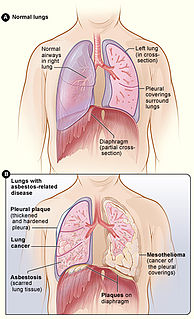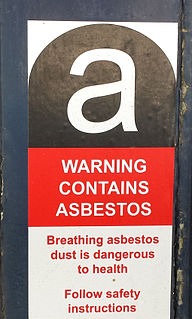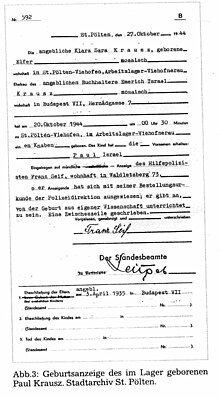
Mesothelioma is a type of cancer that develops from the thin layer of tissue that covers many of the internal organs. The most common area affected is the lining of the lungs and chest wall. Less commonly the lining of the abdomen and rarely the sac surrounding the heart, or the sac surrounding the testis may be affected. Signs and symptoms of mesothelioma may include shortness of breath due to fluid around the lung, a swollen abdomen, chest wall pain, cough, feeling tired, and weight loss. These symptoms typically come on slowly.
James Hardie Industries plc is a global building materials company and the largest global manufacturer of fibre cement products. Headquartered in Ireland, it is a dual-listed company, being listed on the Australian and New York Stock Exchanges. Its management team currently sits in Chicago, Illinois, United States. James Hardie was plagued by several asbestos-related scandals in the 20th century.

Wittenoom is a declared contaminated site and former townsite 1,420 kilometres (880 mi) north-north-east of Perth, in the Hamersley Range in the Pilbara region of Western Australia. The declared contaminated site comprises 50,000 hectares, making it the "largest contaminated site in the southern hemisphere".

Theresienstadt Ghetto was established by the SS during World War II in the fortress town of Terezín, in the Protectorate of Bohemia and Moravia. Theresienstadt served two main purposes: a waystation to the extermination camps, and a "retirement settlement" for elderly and prominent Jews to mislead their communities about the Final Solution. Its conditions were deliberately engineered to hasten the death of its prisoners, and the ghetto also served a propaganda role. Unlike other ghettos, the exploitation of forced labor was not economically significant.
The mission of the Bay Area Holocaust Oral History Project (BAHOHP) is to gather oral life histories of Holocaust survivors, liberators, rescuers, and eyewitnesses. The project is developing and maintaining a catalogue database for public use. Their goal is to provide students, scholars, resource centers on the world, and the general public access to their archives.
Elly Berkovits Gross is a Holocaust survivor and author of several Holocaust related books of poetry and prose. She currently resides in the United States, where she is a frequent invited speaker at museums and schools around the country.
Leopold Rosner was a Polish-born Australian musician. Rosner, who was Jewish, survived the Holocaust in Nazi concentration camps during World War II by playing his accordion for Nazi officials. This earned the attention of Oskar Schindler, who saved his life by having him placed on his famous list. His story became known after Australian author Thomas Keneally's 1982 novel, Schindler's Ark, was adapted into Steven Spielberg's Oscar-winning film, Schindler's List. He appeared in the epilogue of the film at the Schindler's grave on Mount Zion.

Asbestos is a naturally occurring fibrous silicate mineral. There are six types, all of which are composed of long and thin fibrous crystals, each fibre being composed of many microscopic "fibrils" that can be released into the atmosphere by abrasion and other processes. Inhalation of asbestos fibres can lead to various dangerous lung conditions, including mesothelioma, asbestosis, and lung cancer, so it is now notorious as a serious health and safety hazard.

Dov Freiberg born Berek Freiberg, was a Holocaust survivor, writer, and witness at the Eichmann trial and the Demjanjuk case. Freiberg was a prisoner at Sobibor extermination camp where he participated in the Sobibor prisoners' revolt. After the revolt, he managed to escape into nearby woods and survived until the Soviet Army entered in July 1944.
Heather Von St. James is an American cancer survivor, cancer research advocate, and blogger. Von St. James serves as a mesothelioma research funding advocate and conference speaker for the Asbestos Disease Awareness Organization and Mesothelioma Applied Research Foundation.

Asbestos-related diseases are disorders of the lung and pleura caused by the inhalation of asbestos fibres. Asbestos-related diseases include non-malignant disorders such as asbestosis, diffuse pleural thickening, pleural plaques, pleural effusion, rounded atelectasis and malignancies such as lung cancer and malignant mesothelioma.
Lorraine Kember is an Australian author, blogger, caregiver advocate, and an inspirational and motivational speaker.
David John Sugarbaker was an American physician who was chief of the division of general thoracic surgery and the director of the Baylor College of Medicine Lung Institute at CHI St. Luke's Health–Baylor St. Luke's Medical Center in Houston, Texas. He was an internationally recognized thoracic surgeon specializing in the treatment of mesothelioma, the surgical management of malignant pleural mesothelioma, and treatment of complex thoracic cancers.

All types of asbestos fibers are known to cause serious health hazards in humans. The most common diseases associated with chronic exposure to asbestos are asbestosis and mesothelioma.

Gena Turgel was a Jewish Polish author, educator, and Holocaust survivor.

Thousands of Jews lived in the towns of Dęblin and Irena in central Poland before World War II; Irena was the site of the Polish Air Force Academy from 1927. In September 1939, the town was captured during the German invasion of Poland and the persecution of Jews began with drafts into forced labor and the establishment of a Judenrat. A ghetto was established in Irena in November 1940. It initially consisted of six streets and was an open ghetto. Many ghetto inhabitants worked on labor projects for Dęblin Fortress, the railway, and the Luftwaffe. Beginning in May 1941, Jews were sent to labor camps around Dęblin from the Opole and Warsaw ghettos. Conditions in the ghetto worsened in late 1941 due to increased German restrictions on ghetto inhabitants and epidemics of typhus and dysentery.
Renee Bornstein is a French-born Holocaust survivor, living in Manchester, England. She was the wife of Ernst Israel Bornstein, a Polish-born Holocaust survivor and author of Die Lange Nacht, a memoir of his experiences during WWII, published in English as The Long Night.
Paul Kraus is a Holocaust survivor and mesothelioma patient. Paul Kraus may also refer to:
Margot Heuman was a German-born American Holocaust survivor. As a lesbian, she was the first queer Jewish woman known to have survived Nazi concentration camps.









